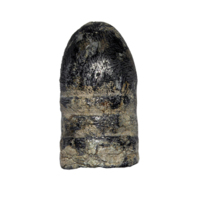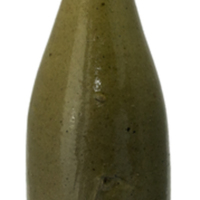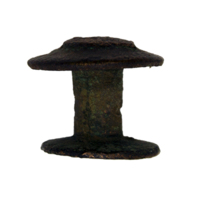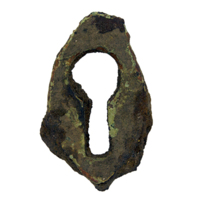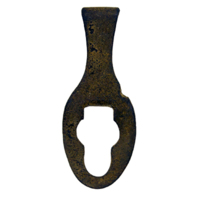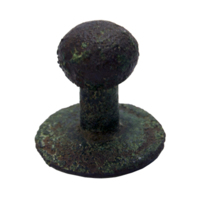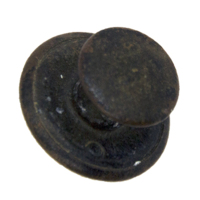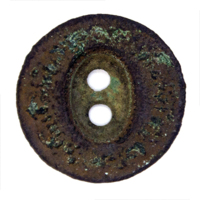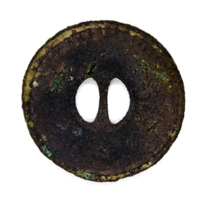Smithfield (1876)
The packers established a camp at the foot of the Douglas Track on the Barron River at Kamerunga, where there was fresh water and food for their horses. A number of people relocated from Cairns, including Old Bill Smith, and before long a shanty town sprung up. There were 30 to 40 shanties, a store, Smith's grog shop, a blacksmiths, and a number of Packers camps and the place became known as Smith's Camp. By early November 1876 there were almost as many people at Smith's Camp as there were in Cairns, and locals were keen to see a township laid out on the Barron River.
Establishing a Barron River Township
Government surveyor John Sharkey visited Smiths' Camp on 9 November 1876, but could not see any benefit in establishing another township so close to Cairns, and with his work completed at Trinity Bay, he returned to Brisbane.1 Sharkey's replacement, Frederick Warner, held a different opinion and recognized the need to formalize the settlement at the Barron River. The day after Sharkey left, Warner announced his intention to go up the Barron the next day to survey the new township.2
There were several potential sites for the Barron River township, including a permanent lagoon at the foot of the range near the proposed new dray road (Macmillan’s Track), and the river crossing near Smith’s Camp at Kamerunga. Macdonald’s road-party cut a track through the thick scrub to another eligible spot on the northern side of the river, one and a half miles downstream of the crossing, where the bank was 20 feet high and higher than at any other point of the navigable portion of the river.3 They made a rough landing on the northern bank, which was densely clothed with rainforest and described as having belts of the finest timber, forming at places jungles as dark and dense as any seen in India with huge cedars up to 15 feet in girth, the trunks upwards of 40 feet above ground before branching. Kauri pine of enormous dimensions and silky oak, mahogany, and fruits of various kinds were abundant.4
Even at this early stage in the development of the township, it was noted that the Barron was subject to flood. This gave some consolation to the people of Cairns who were opposed to the development of a rival settlement. They noted that “Pluvius held the upper hand” at the Barron, as flood marks were to be seen high up the trees. However, they were unable to establish whether floods were an annual, periodical, or highly exceptional occurrence.5
At 10.00 a.m. on 22 November 1876 Warner and St. George left Cairns aboard Ingham’s S.S. Fitzroy and steamed up the Barron to the high bank at Macdonald's landing. The skipper agreed to wait for half-an-hour while Warner and St. George scrambled up the bank and followed the track cut by the road-party, to reconnoitre the position of the proposed new township.6 They met Macdonald, whose road camp was one and a half miles upstream, and the three men returned to the Fitzroy and proceeded a mile upstream to the packers’ camp, where they met Bill Smith. Having taken the celebrated citizen on board, the party returned to the landing where the ceremony of christening the new township began. Tom Pickett, publican at the Leichhardt Hotel in Abbott Street, Cairns, claimed to have taken champagne up to Smithfield in his boat, accompanied by the notorious drover and former officer in the Native Mounted Police, Wentworth D’Arcy Uhr.7
Mr. St. George, after a few neatly turned eulogistic sentences complimentary to Mr. Smith’s praiseworthy perseverance in endeavouring to discover a short and practicable road to the Hodgkinson, gave the name of ‘Smithfield’ to the new township (this will probably be altered to Smithville, as more appropriate). However, this public recognition – although very inadequate – of old Bill’s services was favourably received by those present, and Smith’s health, as also prosperity to the new town, were drunk in copious draughts of champagne and soda.8
St. George returned to Cairns in the Fitzroy that evening, while Warner stayed to lay out the new township of Smithfield. Not everyone was happy with the choice of name:
Smithfield is merely suggestive of the great London cattle market in days gone by, and of a place where witches and martyrs were burned at the stake. Smithville would be much more appropriate for the purpose of handing down the name of Smith the explorer to posterity, and we hope therefore, that it will be changed accordingly.9
These alternative names, Smithville and Smithton, were rejected and Smithfield endured.
Smithfield township
Within three days, the energetic Warner had 40 allotments pegged out along two main streets. Warner noted:
There are two landings [on the river bank] about five chains apart, and a reserve two chains wide has been laid off along the bank, from which the two main streets, starting opposite the landings, run for a distance of ten chains, through thick scrub abounding in good timber for building purposes, to a pocket of open forest-land, after crossing which the new track enters another belt of scrub, on the other side of which is a large extent of good well-grassed country, which is now the favourite turning-out ground for horses, great numbers of which are running there.10
The two main streets, Macdonald Street (named after the Road Works Overseer) and Logan Street were 33 yards wide and ran northwest for 550 yards from the river, and there were two cross streets, Hill (named after the Government Botanist) and Seymour (named after the Police Commissioner). The Esplanade was a two-chain Reserve along the river bank. Warner marked out two sections with 20 allotments in each. Each allotment was 36 perches in area and had a street frontage of 66 feet, double the 33-foot frontages Sharkey had initially laid out in Cairns.11
Most of the packers relocated into Smithfield from Smith’s Camp at the river crossing at Kamerunga. Craig & Co. set up a receiving store and warehouse at the landing facing Macdonald Street, Edward John Nolan of Cardwell set up a similar arrangement at the one facing Logan Street. James Burke and John Regan set up ‘shanties’, with Regan’s known as the ‘Reefer’s Hotel’.12 Moses Rhueben set up a shop, Michael Kelly set up the Royal Exchange Hotel and store, and John and Martha ‘Minnie’ Faler opened the Last Resource Hotel.13 Smith moved into the township and opened the Pioneer Hotel on the eastern side of Macdonald Street near the river.14 The Louisa and Fitzroy came up the Barron from Cairns each day and offloaded their cargoes on the sandy beach at the foot of the high bank.15 Passenger fares were three shillings each way for the 12-mile trip and freight was 15 shillings a ton. Eighty pack-horses arrived from Thornborough down the Douglas and Smith’s Tracks, taking just 13 hours to complete the 60 mile journey, and they were quickly loaded up with stores and supplies and returned to the Hodgkinson.16
By 2 December 1876, Warner had completed his survey of Smithfield and the township was gazetted on 15 December 1876. The following day the Government Gazette announced that 34 town allotments would be sold at auction at the Cairns police station in February next year.17
Smithfield continued to expand with business premises being erected as rapidly as clearings could be made in the forest.18 William Hunter Collinson arrived from the Hodgkinson with a mob of cattle, and with his Cairns business partner, George Mackay, opened Collinson & Mackay butchers on Logan Street.19 Craig & Co. and Nolan & Co. landed large quantities of stores at their Smithfield warehouses and there were so many packers coming down the Douglas Track that goods landed at Cairns had no time to be warehoused, but were promptly trans-shipped into the smaller steamers and sent up the river. Police magistrate St George visited Smithfield again in mid-December 1876, and warned the owners of the Smithfield shanties that the retail of spirituous liquors would now require a licence and they had until the end of the month to apply.20 Regan and Burke’s shanties disappeared, with Burke concentrating on his on his Club House Hotel on Abbott Street in Cairns. Kelly, Faler and Smith were granted publican’s licences and there were a rush of licence applications from the other establishments: Peter Gordon applied for a Publican’s Country Licence for the Royal Hotel, Robert Frillo for Frillo’s Hotel, Henry Koch for the American Hotel, John O’Reefe for the Commercial Hotel and Michael Frank for the Crown Hotel.21 Robert Frith ;and William Wade applied for licences to open hotels outside the township along Macmillan’s Track.22
Smithfield was growing faster than Cairns – and some even referred to the river township as “the new city on the Barron!” The residents of Cairns were concerned that it would not be long before the greater portion of the freight shipped to Trinity Bay ;would by-pass their town and would instead be offloaded into light-draught steamers of the Louisa class at the mouth of the Barron, “to be conveyed forthwith to Smithfield where it could be landed close to the bank and warehoused immediately”.23
The New Township, Barron River, from our own correspondent at Smithville.
I [Police Magistrate, Howard St. George] concluded my last communication –… Survey of Sections Nos. 1 + 2 (Lots 1-20, & 201-220), Town of Smithfield, County of Nares, Land Administration District of Cairns, District of…'The New Township, Barron River' [newspaper report]
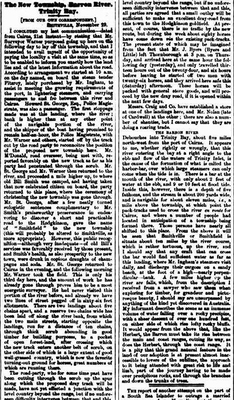
Map S199.1, Smithfield, 1876
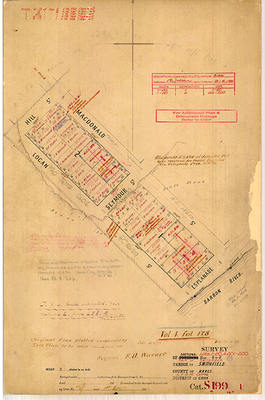
| Go to the next section ⇒ Smithfield expansion (1877). | |
 |
This webpage is an excerpt from the upcoming book Old Smithfield: Barron River township (1876-1879) by Dr Dave Phoenix. Find Out More Here |
Featured Artefacts from Old Smithfield:
-
1. Surveyor John Phillip Sharkey, Plan of sections no. 1 to 30, township of Cairns, district of Cook, 1877, Accession number 85-2-5, Bib 695688, Record number 150383, John Oxley Library, State Library of Queensland; Brisbane Courier, 21 November 1876: 2.. ↩
-
2.Brisbane Courier, 2 December 1876: 5. ↩
-
3.Brisbane Courier, 25 December 1876: 3. ↩
-
4.Queenslander, 10 February 1877: 6. ↩
-
5.Brisbane Courier, 2 December 1876: 5; ‘Pluvius’, a word used in the early 20th century from classical Latin meaning ‘characterized by rain or rainy’. ↩
-
6.Brisbane Courier, 25 December 1876: 3. ↩
-
7.Wentworth D'Arcy Uhr (1845, Queensland–1907, Coolgardie); Sketcher, Queenslander, 28 September 1895: 597; Clem Llewellyn Lack, The Town that was Drowned: Some North Queensland memories and anecdotes, RHSQ Jnl 9, 2 (1971): 231-238. ↩
-
8.Brisbane Courier, 25 December 1876: 3; Queenslander, 30 December 1876: 13. ↩
-
9.Mackay Mercury and South Kennedy Advertiser, 30 December 1876: 2. ↩
-
10.Ibid. ↩
-
11. 36 perches = 910 square metres or just under a quarter acre. ↩
-
12.Cooktown Courier, 15 November 1876: 2. ↩
-
13.Morning Post (Cairns), 30 April 1907: 2; Cairns Morning Post, 15 March 1909: 4; Moses Albert Maurice Rhueben (1842, Hobart–1917, Townsville) married Laura Agnes Elliott (c.1850–1946, Brisbane) in 1880. Martha ‘Minnie’ Brown McNair (1835, Glasgow–1903, Victoria) married John Adolphus William Faler (1830, Finland–1908, New Zealand) in New Zealand in 1869 and had three children. ↩
-
14.Cooktown Herald & Palmer River Advertiser, 3 December 1876: 3; Recently confusion has arisen regarding the name of Smith’s hotel. Smith applied for a Publican’s Country Licence for ‘The Pioneer Hotel’ at Smithfield and a visitor to the township noted there was a sign above the door saying ‘Pioneer Hotel, Old Bill Smith’, see: Cooktown Herald & Palmer River Advertiser, 3 December 1876: 3; Queenslander, 10 February 1877: 6. Forty years after Smith’s death, Michael O’Leary writing under the pseudonym ‘Coyyan’ claimed Smith’s pub was called ‘The Beehive’. This is the first time that the Bee Hive Hotel was mentioned in print, see: Coyyan (pseudonym: Michael O’Leary), Northern Herald (Cairns), 16 June 1916: 22. There are no contemporary accounts from the 1870s that mention Smith’s hotel as the ‘Bee Hive’, but Coyyan’s reference has been repeated with increasing frequency in recent times. Alfred John Martin applied for a Publican’s Licence for the ‘Bee Hive Hotel’ in Cairns, but there is nothing to indicate that he actually opened a hotel in that name, see: Cooktown Courier, 25 November 1876: 4. Martin also purchased land in Smithfield, and after his death he was recalled to have ‘kept a hotel for a time at Smithfield’, but the name of the hotel was not mentioned, see: Cairns Post, 25 August 1919: 4. Another early Cairns pioneer, Alfred Street, owned ‘The Bee Hive’, a drapery and clothing warehouse next door to Collinson & Mackay’s butchers shop on Abbott Street in Cairns. Jones claimed Alfred Street invested heavily in Smithfield, but contemporary accounts do not list him as one of the many businessmen associated with the township, see: Jones, Trinity Phoenix, 101-102. ↩
-
15.Brisbane Courier, 25 December 1876: 3; Queenslander, 30 December 1876: 13. ↩
-
16.Northern Miner (Charters Towers), 6 December 1876: 2. ↩
-
17.Queensland Government Gazette 19 (1876): 1364 (16 December 1876). ↩
-
18.Mackay Mercury and South Kennedy Advertiser, 30 December 1876: 2. ↩
-
19.Mackay Mercury and South Kennedy Advertiser, 30 December 1876: 2. William Hunter Collinson (1840, Sale, Victoria–1916, Yattee, buried Gordonvale), married Jemima Elizabeth Martin nee Napp in 1866, and Dorinda Armstrong in 1878. ↩
-
20.Cooktown Courier, 2 December 1876: 2; Rockhampton Bulletin, 8 December 1876: 2; Capricornian (Rockhampton), 9 December 1876: 786. ↩
-
21.Henry Christopher Koch (c.1831, St. Louis, Missouri–1914? Sydney), married Ellen Tobin (1836, Tipperary–1878, Smithfield) in Sydney in 1854. Cooktown Herald & Palmer River Advertiser, 10 December 186: 3; 17 December 1876: 3; 23 December 1876: 3; 6 January 1876: 3; 13 January 1876: 3. ↩
-
22.Queensland Liquor Licence, Cairns, Retail Spirit Dealers for the year 1877: Henry Koch, Robert Frith, Michael Kelly, Martha Brown Faler (or Faber), William Wade, QGG 20 (1877), 280. ↩
-
23.Mackay Mercury and South Kennedy Advertiser, 30 December 1876: 2. ↩


